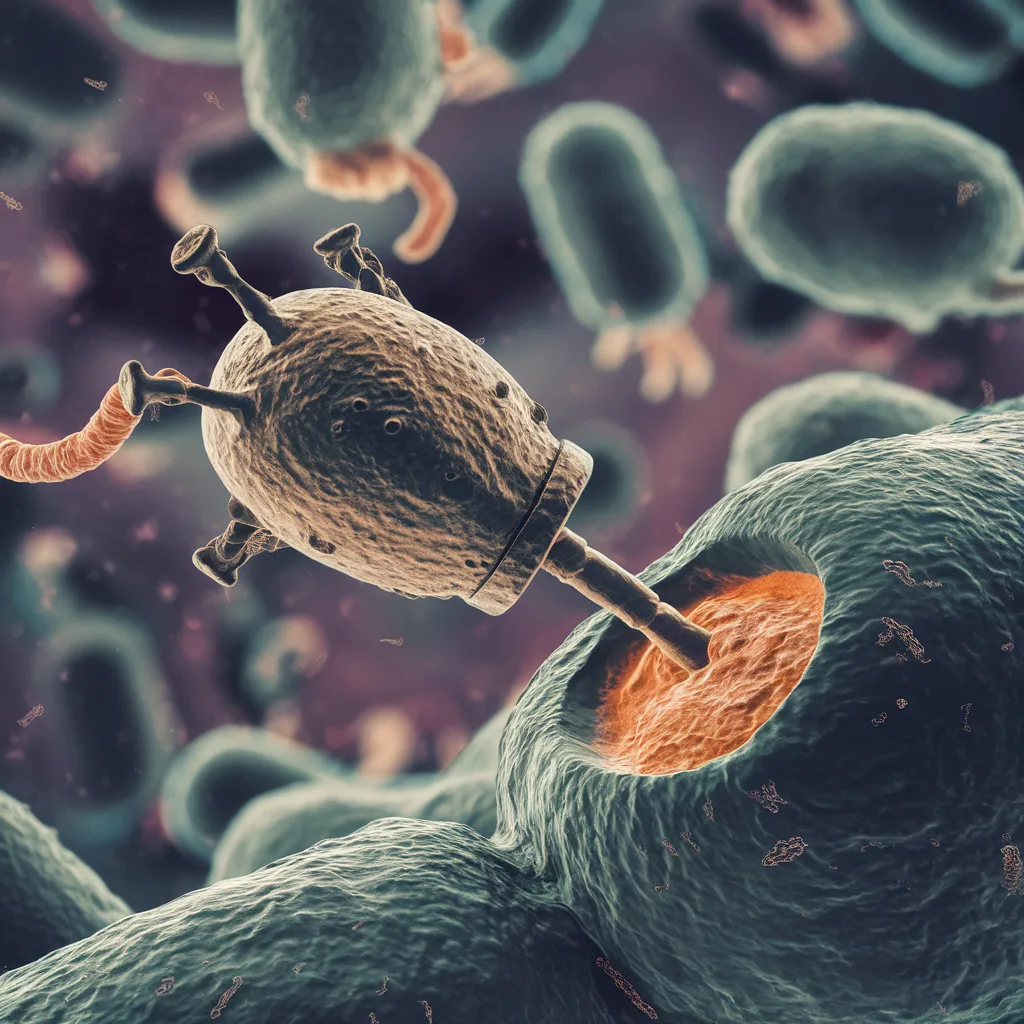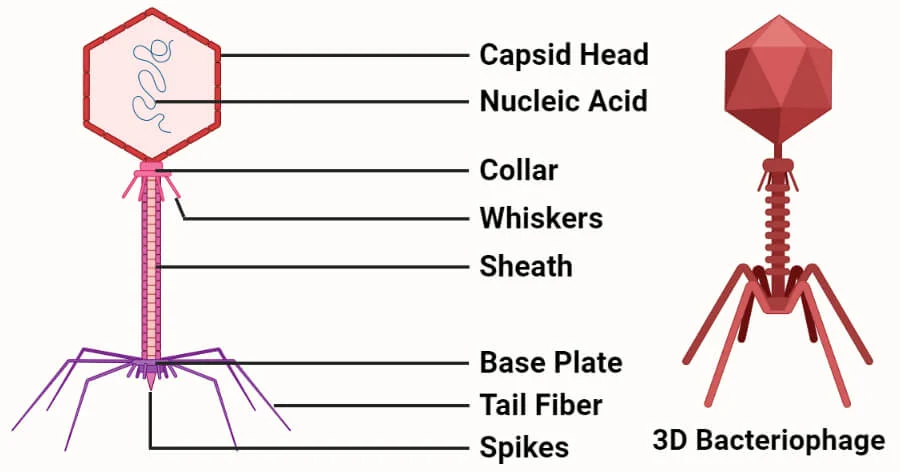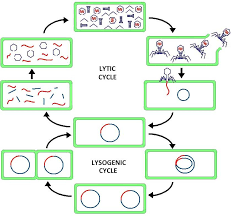Bacteriophages act an important role in bacterial ecology, evolution, and biotechnology. They can alter bacterial populations by triggering host cell lysis, which affects the dynamics of the microbial community. Bacteriophages have also been explored and used in a variety of biotechnological applications, such as phage treatment to treat bacterial infections and phage display for protein engineering and drug discovery.
Table of Contents
What is Bacteriophage?
A bacteriophage, or phage, is a virus that infects and replicates within bacteria. Bacteriophages are made up of a protein covering called a capsid that encloses their genetic material, which is either DNA or RNA. These viruses are extremely specific to specific bacterial species or strains and serve an important role in controlling bacterial populations in a variety of settings.

Structure of Bacteriophage
1. Head (Capsid)
Shape: Typically icosahedral (20-sided), although sometimes extended.
Function: Encases and protects the genetic material from destruction.
Components: It include protein subunits known as capsomeres. It includes the phage’s genetic material, which can be either DNA or RNA, but is typically double-stranded DNA.
2. Tail
Tail Sheath: A contractile structure seen in some phages (such as T4 phages) that aids in the injection of genetic material into hosts. During infection, the sheath contracts and pushes the tail tube through the bacterial cell wall.
Tail Tube: A hollow tube through which genetic material enters the host bacterium.
The Base Plate, located at the end of the tail, is essential for connecting to the bacterial surface. It frequently comprises receptor-binding proteins, enzymes for breaking down the bacterial cell wall, and other features that aid in attachment and penetration.
Tail Fibers: Long, flexible extensions that enable the phage recognize and connect to specific receptors on the bacterial cell surface. These fibers are very particular and determine the phage’s host range.
3. Collar
Position: Located between the head and the tail.
Function: Provides structural support and facilitates the connection between the head and the tail.

Life Cycles of Bacteriophage

1. Lytic Cycle
Attachment (adsorption)
The phage’s tail fibers bind to specific receptors on the bacterial cell’s surface.
penetration (injection)
The phage inserts its genetic material (DNA or RNA) into a bacterial cell. The tail sheath contracts, pushing the tail tube through the bacterial cell wall and membrane.
Biosynthesis
The phage DNA takes over the bacterial cell’s machinery, instructing it to generate phage components (proteins and nucleic acids). The host DNA is frequently degraded.
Assembly (Maturation)
Newly generated phage components are combined to form full virions. The phage DNA is packed into heads with tails attached.
Release (Lysis)
Phage-encoded enzymes lyse the bacterial cell wall, releasing freshly produced phages into the environment where they can infect other bacteria.
2. Lysogenic Cycle
Attachment (adsorption)
The phage adheres to the surface of the bacterial cell, just like in the lytic cycle.
penetration (injection)
The phage injects DNA into the bacterial cell.
Integration
The phage DNA integrates into the bacterial chromosome and becomes a prophage. This integration is facilitated by particular recombination enzymes.
Dormancy (lysogeny)
During cell division, the prophage passively replicates alongside the host cell’s DNA. The prophage does not affect the host at this stage and can remain inactive for a long time.
Induction
Certain factors (such as stress or UV light) can cause the prophage to separate from the bacterial chromosome and enter the lytic cycle. The phage DNA is then expressed, resulting in the creation of additional phages.
Biosynthesis, Maturation, and Release
The biosynthesis, maturation, and release processes are comparable to the lytic cycle, resulting in the generation and release of new phages.
Applications of Bacteriophage
Phage Therapy
In the treatment of bacterial illnesses, phages have been utilized instead of antibiotics. With the rise of antibiotic-resistant bacteria, phage therapy has gained popularity as a possible treatment
Phage therapy uses particular phages to target and eliminate harmful germs. These phages connect to bacterial surfaces, inject genetic material, and proliferate within the bacterial host, ultimately destroying it.
Biotechnology
Phages are valuable tools in biotechnology. They can be applied to genetic engineering, protein expression, and vaccine manufacture.
Due to their huge size, filamentous phages are very valuable for medication administration and as biomarker agents.
Diagnostic Applications
Phages have been used for diagnostic purposes, including phage typing. This approach distinguishes bacterial strains depending on their susceptibility to certain phages. Other applications for phages include infection monitoring and disease diagnosis.
Environmental and Bioremediation Applications
Phages are important in environmental research in addition to their therapeutic applications.
They are used for monitoring water quality, nitrogen cycling, and bioremediation (cleaning contaminants) in diverse habitats.
Surface Decontamination
Phages can be used to disinfect surfaces such as food preparation areas and medical equipment.
By focusing on certain bacteria, they help to lower bacterial burden and prevent illnesses.
Phage Therapy of Bacteriophage
Targeted Treatment
Phages are viruses that only infect and reproduce within bacterial cells. Each phage type has a unique host range, which means it can only infect certain bacteria.
Phage therapy involves identifying phages that can target the harmful bacteria that are causing the infection. These phages adhere to the bacterial surface, inject genetic material, and reproduce within the bacterial host.
Advantages
Unlike broad-spectrum antibiotics, phages are extremely specialized. They exclusively kill infectious bacteria, leaving healthy bacteria undisturbed.
Adaptability: Phages can change quickly in response to bacterial alterations, making them potentially effective against antibiotic-resistant strains.
Challenges
Isolation: Identifying appropriate phages for a given illness might be difficult.
Regulation: Phage therapy confronts regulatory challenges due to its individualized nature and the requirement for specific treatments.
Clinical Applications
Localized Infections: Phage treatment is commonly used to treat localized infections.
Chronic Infections: It may be used to treat chronic infections when antibiotics fail.
Biofilm Disruption: Phages can help break down bacterial biofilms, which are frequently resistant to antibiotics.
Research and Future Prospects
Ongoing research attempts to improve phage therapy methods, phage delivery, and safety.
To maximize efficacy, combination therapy (phages and antibiotics) are being investigated.
Frequently Asked Question (FAQ)
What is Bacteriophage?
A bacteriophage, or phage, is a virus that infects and replicates within bacteria. Bacteriophages are made up of a protein covering called a capsid that encloses their genetic material, which is either DNA or RNA.
What are Applications of Bacteriophage?
The application of Bacteriophage are:
1. Phage Therapy
2. Biotechnology
3.Diagnostic Applications
4.Environmental and Bioremediation Applications
Related Article

